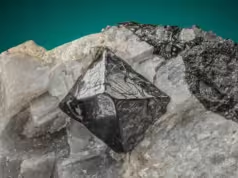Minerals
A mineral is a naturally occurring chemical compound usually of crystalline form and not produced by life processes. A mineral has one specific chemical composition, whereas a rock can be an aggregate of different minerals or mineraloids. The study of minerals is called mineralogy. To meet the definition of “mineral” used by most geologists, a substance must meet five requirements:
Apatite
Apatite is a very common mineral, but transparent gemstone-quality apatite is extremely rare. Despite the fact that apatite is the defining mineral for 5 on Mohs scale of hardness, the gemstone remains virtually unknown to most, and is seldom found in jewelry stores.
Andalusite
Andalusite is a rock forming minerals and is an aluminium nesosilicate minerals with the chemical formula Al2SiO5.At higher temperatures and pressures, andalusite may convert to sillimanite.andalusite is an aluminosilicate index mineral, providing clues to depth and pressures involved in producing the host rock.
Obsidian
Obsidian is an igneous rock that forms when molten rock material cools so rapidly that atoms are unable to arrange themselves into a crystalline structure. It is an amorphous material known as a "mineraloid." The result is a volcanic glass with a smooth uniform texture that breaks with a conchoidal fracture .
Fluorite (Fluorspar)
Fluorite, also called fluorspar, common halide mineral, calcium fluoride (CaF2), which is the principal fluorine mineral. It is usually quite pure, but as much as 20 percent yttrium or cerium may replace calcium. Fluorite occurs most commonly as a glassy, many-hued vein mineral and is often associated with lead and silver ores; it also occurs in cavities, in sedimentary rocks, in pegmatites, and in hot-spring areas
Halite
Culinary rock salt is actually halite. Its name is derived from the Greek word hals, which means “salt.” Most halite is colorless, white, gray, orange, or brown, but it can also be bright blue or purple. The orange color comes from inclusions of hematite, while the blue and purple colors indicate defects in the crystal structure.
Gypsum
Gypsum, common sulfate mineral of superb industrial significance, composed of hydrated calcium sulfate (CaSO4 ·2H2O). In properly-developed crystals the mineral normally has been called selenite. The fibrous large variety has a silky lustre and is known as satin spar
Anhydrite
Anhydrite is one of the minerals that make up the rocks. Chemical structure similar to Gypsum but does not contain water. Formula is CaSO4.There is a sedimentary basin in large areas where sea water evaporates. It is usually found in salt deposits with gypsum next to it. Anhydrite may form on the coastline or tidal flat deposits caused by the evaporation of seawater.
Barite
The barium sulfate barite takes its name from the Greek word barys, which means “heavy” a reference to its high specific gravity. It has also been called heavy spar. Barite crystals are sometimes tinged yellow, blue, or brown. Golden barite comes from South Dakota. Crystals are well formed, usually either prismatic or tabular.
Molybdenite
A molybdenum sulfide, molybdenite is the most important source of molybdenum, which is an important element in high-strength steels. Molybdenite was originally thought to be lead, and its name is derived from the Greek word for lead, molybdos. It was recognized as a distinct mineral by the Swedish chemist Carl Scheele in 1778.
Pyrite (Fool’s Gold)
Known since antiquity, pyrite is commonly referred to as “fool’s gold.” Although much lighter than gold, its brassy color and relatively high density misled many novice prospectors. Its name is derived from the Greek word pyr, meaning “fire,” because it emits sparks when struck by iron.
Stibnite
The principal ore of antimony, stibnite is antimony sulfide. Its name comes from the Latin stibium. Lead-gray to silvery gray in color, it often develops a black, iridescent tarnish on exposure to light. It normally occurs as elongated, prismatic crystals that may be bent or twisted.
Orpiment
An arsenic sulfide, orpiment is a soft yellow or orange mineral. Widely distributed, it is typically powdery or massive, but it is also found as cleavable, columnar, or foliated masses. Distinct crystals are uncommon, but when found they are short prisms.











































